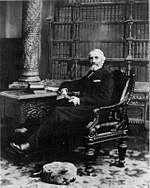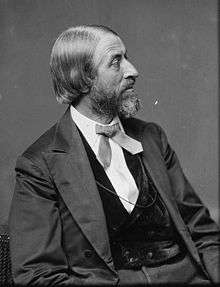Ainsworth Rand Spofford
Ainsworth Rand Spofford (September 12, 1825 – August 11, 1908) was an American journalist and the sixth Librarian of Congress.
Ainsworth Rand Spofford | |
|---|---|
 | |
| 6th Librarian of Congress | |
| In office December 31, 1864 – July 1, 1897 | |
| President | |
| Preceded by | John Gould Stephenson |
| Succeeded by | John Russell Young |
| Personal details | |
| Born | September 12, 1825 Gilmanton, New Hampshire, USA |
| Died | August 11, 1908 (aged 82) Holderness, New Hampshire |
| Occupation | Publisher, journalist |
Early life

Spofford was born in Gilmanton, New Hampshire. Ill health prevented him from attending Amherst College. He instead, at age 19, moved to Cincinnati, Ohio, where he became a bookseller, publisher, and newspaper man.
In 1849 Spofford founded the Literary Club of Cincinnati with John Celivergos Zachos, Stanley Matthews (Supreme Court justice) and 12 others founded. One year later Rutherford B. Hayes became a member. Other prominent members included William Howard Taft and notable club guests Ralph Waldo Emerson, Booker T. Washington, Mark Twain, and Robert Frost. In 1850 prominent abolitionist and woman's rights activist John Celivergos Zachos named his son Ainsworth to honor Spofford.[1]
In 1851, in response to the Fugitive Slave Law, he published the pamphlet The Higher Law, Tried by Reason and Authority, which argued that "Injustice is the only treason; no law can legalize it, no constitution can sanction it." Readers included Ralph Waldo Emerson, who shared Spofford's antislavery principles. In 1859 Spofford became associate editor of the Cincinnati Commercial. He was also active in Republican party politics and was a delegate to the 1856 Republican National Convention, at which John C. Frémont was nominated.
While in Washington D.C. in 1861, shortly after reporting on the First Battle of Bull Run for The Cincinnati Commercial, Spofford accepted the position of Chief Assistant Librarian of Congress. Once Spofford learned of the retirement of Librarian of Congress John G. Stephenson, Spofford gathered enough political endorsements for the job, which later led President Abraham Lincoln to promote Spofford to the post of Librarian of Congress in 1864.
Librarian of Congress
Spofford served as the Librarian of Congress from 1864 to 1897, a tenure that saw the expansion of the Library's collections and notable changes in its methods of collection development. According to the Library's published history, Spofford contributed to the Jeffersonian vision for the library that a “democratic form of government depended on a comprehensive base of knowledge and information.”[2]
Spofford is generally credited with overseeing the expansion of the Library from a Congressional resource into a national institution. During Spofford's tenure, the Library's collection expanded from over 60,000 items to more than one million. Among his more noted acquisitions was the purchase of a vast collection of early American archives from noted archivist Peter Force.[3] Spofford's hopes were to follow the great library models of Europe, in which "the library would be a comprehensive collection of the literature of the nation."[2] Beginning in the 1830s, the Library of Congress began to receive foreign governmental documents and publications. By the late 1860s, Spofford convinced Congress to allow the Library to become the repository for international documents. Spofford stated that "there is almost no work, within the vast range of literature and science, which may not at some time prove useful to the legislature of a great nation."[4] Spofford's championing of the Copyright Law, passed on July 8, 1870, also expanded the Library's collection through the copyright registration deposit mandate. The law "centralized all U.S. copyright registration and deposit activities at the Library."[5] and stipulated that two copies of every "book pamphlet, map, print, photograph, and piece of music registered for copyright be deposited in the Library."[2] In arguing for the deposit requirement, Spofford suggested that the legislature would "provide a repository of American culture."[6] In his argument for the copyright law to Congress, Spofford wrote that "the Public intelligence and welfare are promoted by every extension of the means of acquiring knowledge." The law established the Library as the de facto national library of the United States and "essentially resolved [any] debate over which institution would serve as America's national library."[6] Congress appropriated funds for a new building to house the expanding collections in 1886. This building was completed in 1897 and is now known as the Thomas Jefferson Building.
In 1897, Spofford stepped aside in favor of a younger administrator, John Russell Young, and returned to his old post of Chief Assistant Librarian, where he remained until his death. Spofford also held a post as Professor and Department Head of Library Science at the Columbian University in Washington, D.C.[7] During his retirement, Spofford wrote and published A Book for All Readers, and was described by the New York Times as "written from the fullness of knowledge and experience of a veteran librarian for the guidance of younger members of his chosen profession."[8]
Posthumous reception
While doing research on Spofford, John Y. Cole discovered that while Ainsworth's ashes were interred at Rock Creek Cemetery in Washington, D.C., his tombstone was blank, although his wife's name was there. Spofford was also not listed in the cemetery's handout that noted the famous people buried there. Although Cole was responsible for bringing this to the attention of some Spofford descendants, nothing was done to correct this until 2004, when John Spofford Morgan, Ainsworth Spofford's great-grandson (1917–2015), saw to it that the situation was remedied. Today, the tombstone reads, "Ainsworth Rand Spofford, 1825–1908, Librarian of Congress, 1864–1897, Appointed by President Lincoln." His name is also now listed in the cemetery's handout on notable figures whose tombstones can be viewed there.[9]
References
- "Topping, Eva Catafygiotu" John Zachos Cincinnatian from Constantinople The Cincinnati Historical Society Bulletin Volumes 33-34 Cincinnati Historical Society 1975: p. 54
- Cole, John (March 30, 2006). "Jefferson's Legacy: A Brief History of the Library of Congress". Library of Congress. Archived from the original on January 10, 2009. Retrieved January 3, 2009.
- Spofford, 1898, pp. 5–6
- Cole, John (2005). "The Library of Congress Becomes a World Library, 1815–2005". Libraries & Culture. 40 (3): 3.
- "Ainsworth Rand Spofford". Library of Congress. Retrieved February 5, 2018.
- Dement, Ellen C. (2017). "The making of a national library: The Library of Congress as a cultural product of the late nineteenth century" (PDF). Vanderbilt Historical Review. 2: 74–81.
- "Catalogue of the Columbian College in the District of Columbia. 1898–1901". HathiTrust. Retrieved June 8, 2018.
- Murray, Stuart. The Library: An Illustrated History. New York, NY: Skyhorse Pub, 2009.
- "Ainsworth's Ashes: Final Resting Place of a Seminal Librarian of Congress". Library of Congress Information Bulletin. March 2005, v. 64 no. 3, p. 75. https://www.loc.gov/loc/lcib/0503/ainsworth.html. Retrieved 2009-10-18
Sources
- Spofford, Ainsworth Rand (1898). The Life and Labors of Peter Force, Mayor of Washington. Washington, The Society.
External links
- . New International Encyclopedia. 1905.
- Works by Ainsworth Rand Spofford at Project Gutenberg
- Works by or about Ainsworth Rand Spofford at Internet Archive
